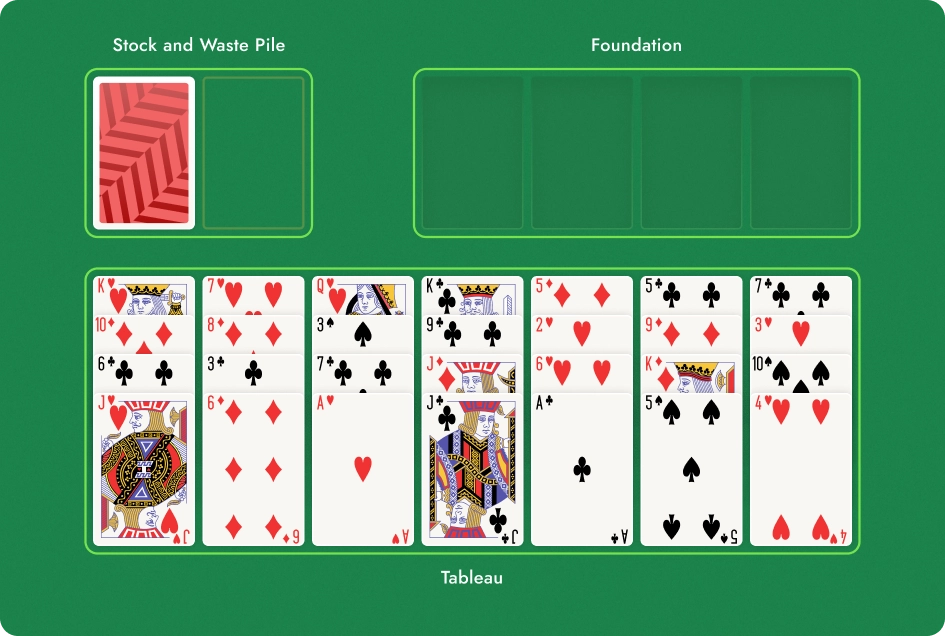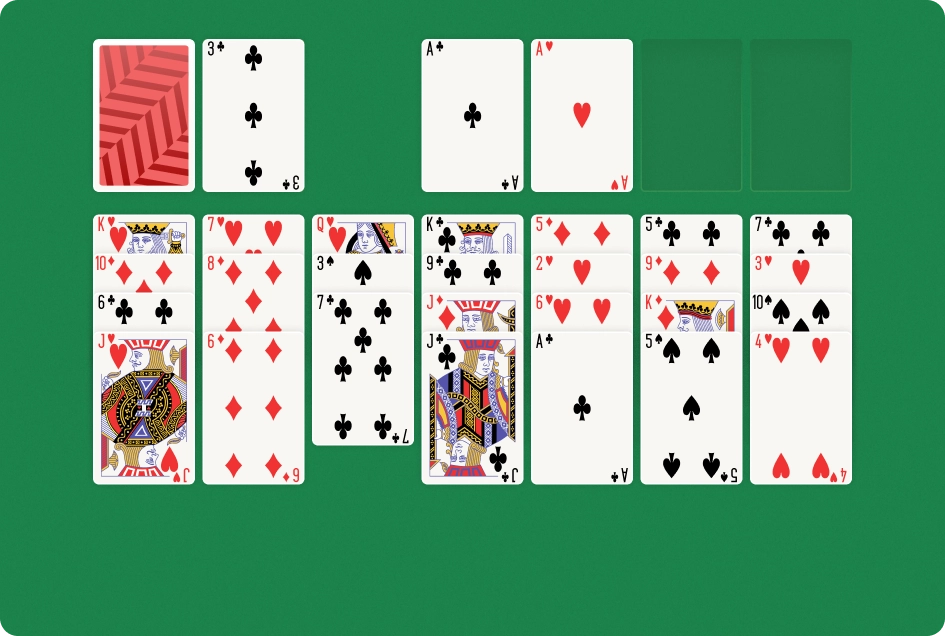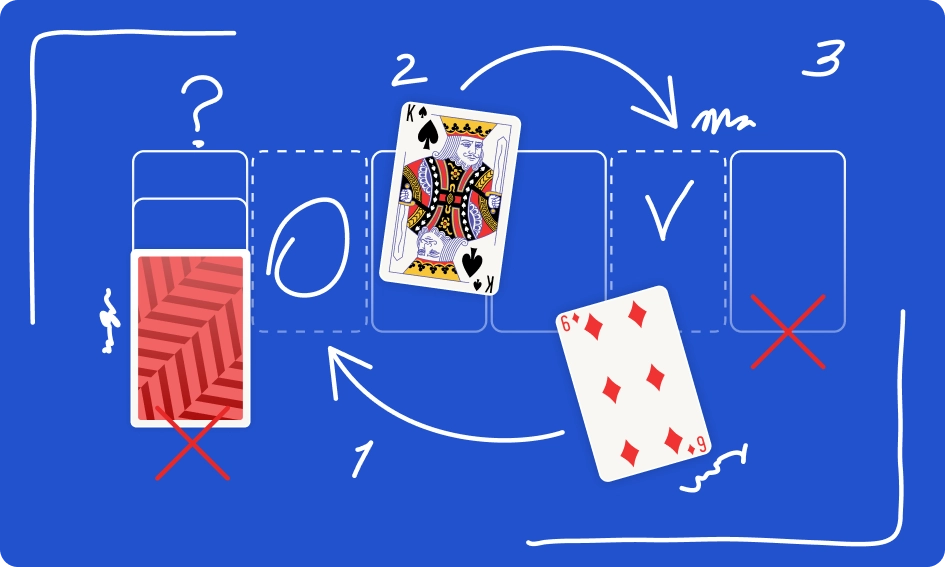Like most people, I like a bit of a change from time to time. While searching for an exciting Solitaire game that was different from what I usually played, I found Australian Patience. When I saw its unique layout, I knew I was in for a challenge. This Solitaire variant also has an intriguing and novel style. It presents a puzzle for Solitaire enthusiasts seeking a new adventure. It does, however, have a win rate of just 14%.
Australian Patience is a mixture of Yukon and Klondike Solitaire. The moment I started playing, I realized that this variant is unlike any other Solitaire game I had encountered before. Trust me, once you start playing this game, you won’t be able to get enough.
History of Australian Patience

While the history of Solitaire spans several centuries, Australian Patience is relatively new. Being fond of history, I dug deep and found out that this variant was first introduced in Thomas Warfield’s Pretty Good Solitaire, which contains over 1,000 different Solitaire card games.
Australian Patience quickly gained in popularity and is loved by players from around the world. The game is now often available on various Solitaire websites and apps, which affirms that it is a favorite among Solitaire enthusiasts like me.
The Main Objective in Australian Patience

Australian Patience is considered to be more difficult than Yukon Solitaire. The game can feel like a continuous battle to get cards that are out of reach. It has, nonetheless, become one of my top five Solitaire games.
The main goal in this variant is to move all cards to the four foundation piles above the tableau. Each pile begins with an Ace, and you can then add cards on top of it in ascending rank. You can move cards from the tableau or the waste pile. The best part about the game is that it is easy to learn. It will definitely grow on you once you start playing.
How to Set Up the Game
There isn’t much information about Australian Patience available. But don’t worry, the following steps will help you set up the game:
- Start by shuffling a deck of 52 cards. Try to shuffle at least five times to ensure that the cards are properly randomized.
- Lay out seven cards face-up. These will form the seven columns in the tableau.
- Now add three rows to the one you just laid out. (Remember that all cards must be face-up.)
- Place the remainder of the deck to the side so that you can use it during the game as the stock.
How to Play Australian Patience

Australian Patience might seem difficult, but once you learn the ropes, the gameplay becomes quite easy. Here’s a guide on how to do so:
- The primary goal is to move the cards from the tableau to the foundation piles.
- If the Aces are in the tableau, then move them to the foundation piles to start a sequence. However, if they aren’t, then try to make the best possible sequences in the tableau.
- You can move cards in the tableau as long as the suit is the same and the moved card is one rank lower than the top card. For instance, you can place a Nine of Diamonds on top of a Ten of Diamonds.
- Continue to make sequences in descending order.
- When you can’t make any more moves, you can use the deck to get a new card.
- If you reach the end of the deck, then you can’t use it any longer. So, you will only see the deck once. This is part of what makes the game difficult.
- You win the game if you move all the cards to the four foundation piles.
Strategies to Win at Australian Patience

This Solitaire variant might look daunting at first glance. But, with a few tricks up your sleeve, you can successfully navigate it. I have delved into the intricacies of this challenging game and tested some strategies that can help you conquer it. Here are some key strategies I use to increase my chances of winning.
Don’t Move a King Until Needed
It’s crucial to avoid moving Kings unless absolutely necessary. You should try to move Kings to their own tableau piles when an opportunity arises. This allows each King to start its own sequence. Carefully consider each move involving Kings because they can easily block other sequences. Instead of hastily relocating them, aim to create dedicated piles for Kings when possible. Remember, only Kings can fill empty tableau spots, so use this rule to your strategic advantage.
Plan Your Moves
In my experience, planning is the golden rule in Australian Patience. Doing so allows you to gain a sense of control over the game’s rather chaotic layout. When you start a game, spend at least five minutes scanning the tableau and observing it. This will ensure that no cards or opportunities go unnoticed.
One time, I found myself facing a very cluttered tableau. I felt overwhelmed just looking at it. Yet, instead of giving in to the pressure, I took a deep breath and analyzed the tableau with a clear head. By planning my moves and anticipating future scenarios, I was able to untangle the Tableau.
Don’t Risk Unsafe Moves
Steer clear of risky moves when playing Australian Patience. You should, for instance, avoid moves that could result in a lower-ranked card being placed above a higher one of the same suit in the same pile. Such moves create conflicts down the line and I try my best to avoid them. It is essential to prioritize stability and maintain a clear path for card movements. This ensures a smooth progression through the game.
Avoid Using the Stock Unnecessarily
Now, I completely understand the stock’s allure. It can attract players with its fresh cards and new opportunities. It’s easy to see why players are drawn to it, especially when faced with a challenging situation. I was one of those players who used the stock excessively whenever a challenge arose.
However, I realized that doing so can just prolong the game. Plus, in Australian Patience, you can’t use the deck once you’ve seen all the cards in it. So, now I only use the stock as a last option. Remember to exercise caution and restraint when picking a card from the stock because it can lead to impulsive decisions.
| Strategy | Description |
| Don’t move a King until needed. | Moving the Kings can cause blockages when making sequences. |
| Plan your moves. | Analyze the tableau and preplan your moves to avoid missing any unnoticed opportunities. |
| Don’t risk unsafe moves. | Risky moves – such as placing a lower-ranked card above a higher one – can mess up the layout. |
| Avoid using the stock unnecessarily. | Excessively using the stock will give you extra cards, but this can be chaotic to manage. |
Conclusion
Playing a variety of games can be a refreshing break from your monotonous routine. From my experience, Australian Patience is definitely worth exploring. The unique blend of Yukon and Klondike ensures that you keep coming back for more. Like many other Solitaire variants, this game provides a deserving escape from your everyday hustle. So, if you’re looking for a new adventure, try out Australian Patience right now!





